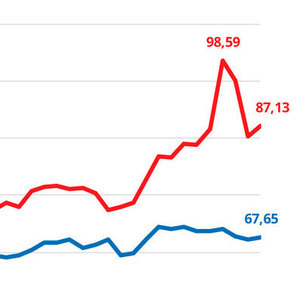Low river levels in Germany continue to push biodiesel prices up

December 11, 2018
BY UFOP
It is often argued that the EU biofuels policy drives prices for agricultural feedstock, yet there is nothing to prove this.
When prices for agricultural commodities and staple foods exploded globally in 2007 and 2008 and prices became volatile as a result, the focus was on issues surrounding global nutrition. Continued famine and poverty since then have primarily been associated with changes in international prices for agricultural feedstock and the promotion of biofuels. Environmental associations in particular have frequently, and very effectively, made the case that the main cause is in the EU’s biofuels policy.
However, they fail to take into account that according to the United Nations’ Food and Agriculture Organization, suppliers respond by intensifying production and increasing yields. For several years now, bumper crops have led to global oversupply and, as a consequence, a build-up of stocks at high levels.
At the same time, the shares of biofuels in the top agricultural commodity exporting countries in Asia and North and South America reached new record highs. Governments have responded to the surpluses by raising the national biofuels mandates to stabilize producer prices.
Advertisement
The current biodiesel hype, which has little impact on selling prices of raw rapeseed oil, shows that fuel prices have little influence on agricultural commodity prices. Demand for rapeseed methyl ester over the past few weeks caused a decline in supply, but feedstock remained abundant at all times. Consequently, rapeseed oil prices only rose slightly. At the same time, the price gap between rapeseed oil and palm oil widened to approximately 300 euros per metric ton, according to information published by Agrarmarkt Informations-Gesellschaft mbH (AMI).
The key issue affecting the product chain of rapeseed processing and biodiesel production in Germany is the uncertain transport situation due to low water levels in Germany's rivers that have curtailed the flow of goods and led to rising prices.
Advertisement
Related Stories
The USDA’s National Agricultural Statistics Service on June 30 released its annual Acreage report, estimating that 83.4 million acres of soybeans have been planted in the U.S. this year, down 4% when compared to 2024.
SAF Magazine and the Commercial Aviation Alternative Fuels Initiative announced the preliminary agenda for the North American SAF Conference and Expo, being held Sept. 22-24 at the Minneapolis Convention Center in Minneapolis, Minnesota.
Saipem has been awarded an EPC contract by Enilive for the expansion of the company’s biorefinery in Porto Marghera, near Venice. The project will boost total nameplate capacity and enable the production of SAF.
Global digital shipbuilder Incat Crowther announced on June 11 the company has been commissioned by Los Angeles operator Catalina Express to design a new low-emission, renewable diesel-powered passenger ferry.
Scientists at ORNL have developed a first-ever method of detecting ribonucleic acid, or RNA, inside plant cells using a technique that results in a visible fluorescent signal. The technology could help develop hardier bioenergy and food crops.
Upcoming Events










